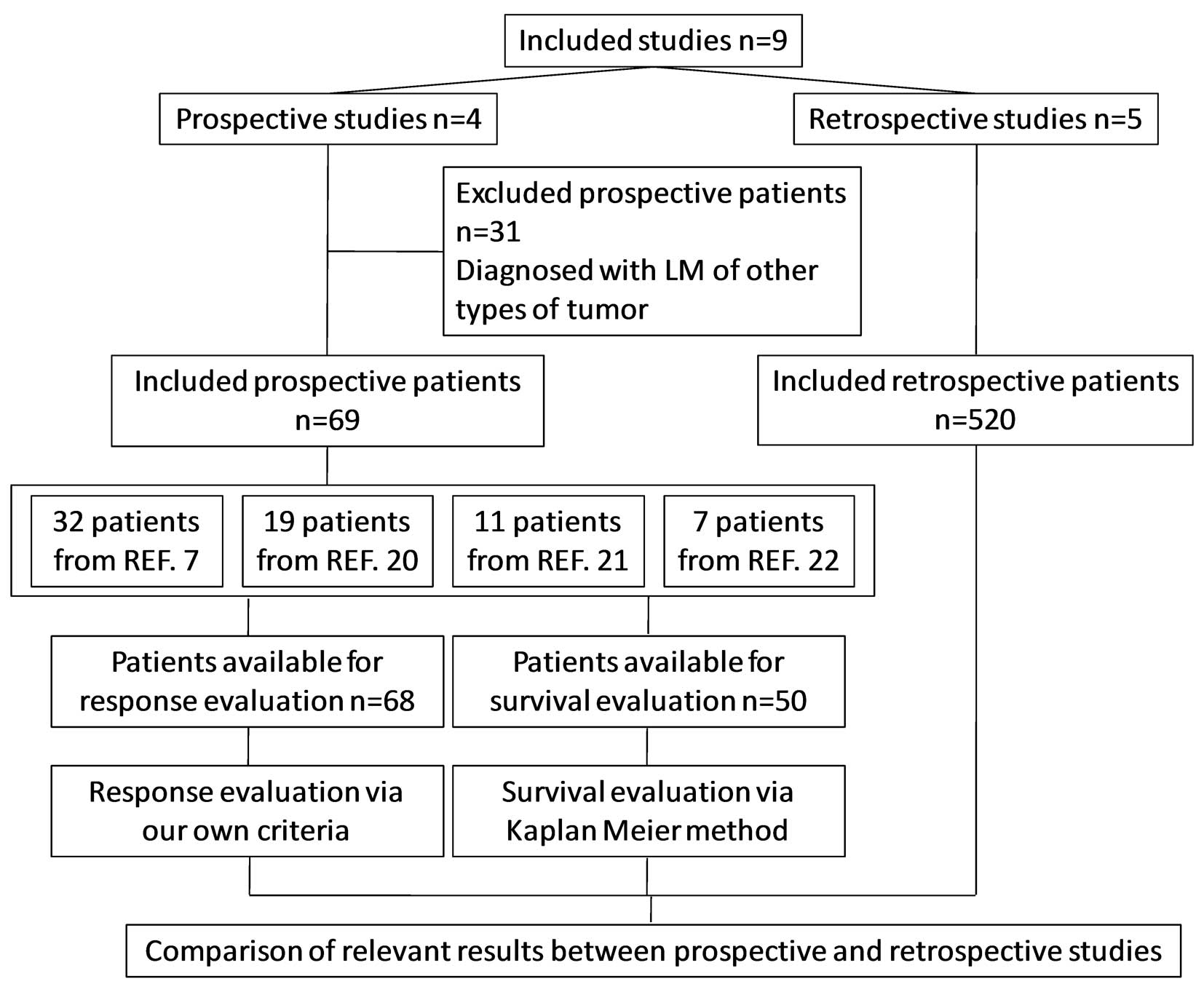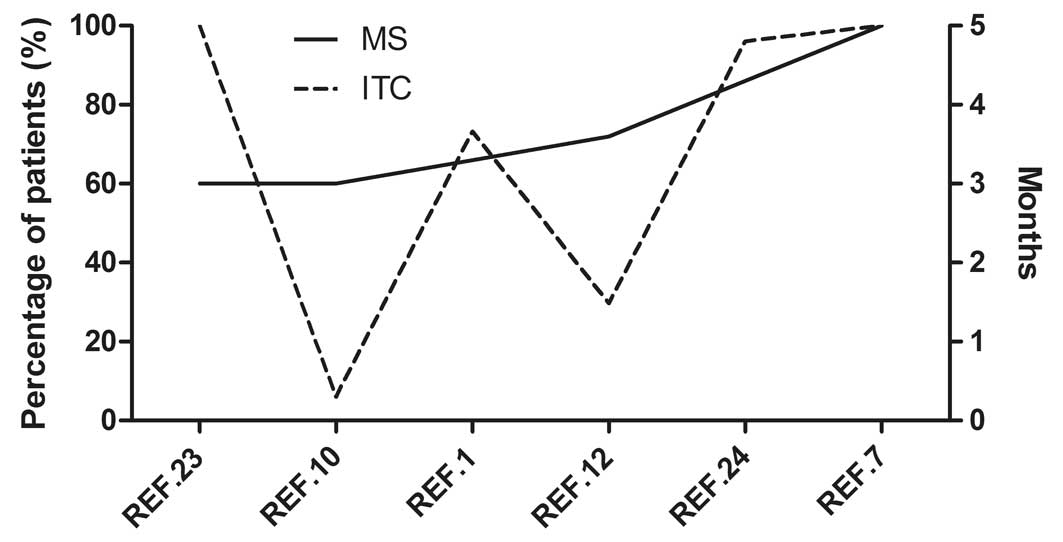|
1
|
Lee SJ, Lee JI, Nam DH, Ahn YC, Han JH,
Sun JM, Ahn JS, Park K and Ahn MJ: Leptomeningeal carcinomatosis in
non-small-cell lung cancer patients: Impact on survival and
correlated prognostic factors. J Thorac Oncol. 8:185–191. 2013.
View Article : Google Scholar : PubMed/NCBI
|
|
2
|
Christoph DC and Reckamp KL:
Intraventricular chemotherapy for leptomeningeal carcinomatosis
from lung cancer: A feasible and beneficial treatment option? J
Thorac Oncol. 8:523–524. 2013. View Article : Google Scholar : PubMed/NCBI
|
|
3
|
Nagpal S, Riess J and Wakelee H: Treatment
of leptomeningeal spread of NSCLC: A continuing challenge. Curr
Treat Options Oncol. 13:491–504. 2012. View Article : Google Scholar : PubMed/NCBI
|
|
4
|
Waki F, Ando M, Takashima A, Yonemori K,
Nokihara H, Miyake M, Tateishi U, Tsuta K, Shimada Y, Fujiwara Y
and Tamura T: Prognostic factors and clinical outcomes in patients
with leptomeningeal metastasis from solid tumors. J Neurooncol.
93:205–212. 2009. View Article : Google Scholar : PubMed/NCBI
|
|
5
|
Hustu HO, Aur RJ, Verzosa MS, Simone JV
and Pinkel D: Prevention of central nervous system leukemia by
irradiation. Cancer. 32:585–597. 1973. View Article : Google Scholar : PubMed/NCBI
|
|
6
|
Wasserstrom WR, Glass JP and Posner JB:
Diagnosis and treatment of leptomeningeal metastases from solid
tumors: Experience with 90 patients. Cancer. 49:759–772. 1982.
View Article : Google Scholar : PubMed/NCBI
|
|
7
|
Chamberlain MC and Kormanik P: Carcinoma
meningitis secondary to non-small cell lung cancer: Combined
modality therapy. Arch Neurol. 55:506–512. 1998. View Article : Google Scholar : PubMed/NCBI
|
|
8
|
Liaw CC, Ng KT, Huang JS, Wang CH, Kiu MC
and Lai GM: Meningeal carcinomatosis from solid tumors: Clinical
analysis of 42 cases. J Formos Med Assoc. 91:299–303.
1992.PubMed/NCBI
|
|
9
|
Taillibert S and Hildebrand J: Treatment
of central nervous system metastases: Parenchymal, epidural, and
leptomeningeal. Curr Opin Oncol. 18:637–643. 2006. View Article : Google Scholar : PubMed/NCBI
|
|
10
|
Morris PG, Reiner AS, Szenberg OR, Clarke
JL, Panageas KS, Perez HR, Kris MG, Chan TA, DeAngelis LM and Omuro
AM: Leptomeningeal metastasis from non-small cell lung cancer:
Survival and the impact of whole brain radiotherapy. J Thorac
Oncol. 7:382–385. 2012. View Article : Google Scholar : PubMed/NCBI
|
|
11
|
Yi HG, Kim HJ, Kim YJ, Han SW, Oh DY, Lee
SH, Kim DW, Im SA, Kim TY, Kim CS, et al: Epidermal growth factor
receptor (EGFR) tyrosine kinase inhibitors (TKIs) are effective for
leptomeningeal metastasis from non-small cell lung cancer patients
with sensitive EGFR mutation or other predictive factors of good
response for EGFR TKI. Lung Cancer. 65:80–84. 2009. View Article : Google Scholar : PubMed/NCBI
|
|
12
|
Umemura S, Tsubouchi K, Yoshioka H, Hotta
K, Takigawa N, Fujiwara K, Horita N, Segawa Y, Hamada N, Takata I,
et al: Clinical outcome in patients with leptomeningeal metastasis
from non-small cell lung cancer: Okayama lung cancer study group.
Lung Cancer. 77:134–139. 2012. View Article : Google Scholar : PubMed/NCBI
|
|
13
|
Nakamura Y, Takahashi T, Tsuya A, Naito T,
Kenmotsu H, Ono A, Shukuya T, Murakami H, Harada H, Watanabe R, et
al: Prognostic factors and clinical outcome of patients with lung
adenocarcinoma with carcinomatous meningitis. Anticancer Res.
32:1811–1816. 2012.PubMed/NCBI
|
|
14
|
Lee E, Keam B, Kim DW, Kim TM, Lee SH,
Chung DH and Heo DS: Erlotinib versus gefitinib for control of
leptomeningeal carcinomatosis in non-small-cell lung cancer. J
Thorac Oncol. 8:1069–1074. 2013. View Article : Google Scholar : PubMed/NCBI
|
|
15
|
Chamberlain MC: Leptomeningeal metastasis.
Curr Opin Oncol. 22:627–635. 2010. View Article : Google Scholar : PubMed/NCBI
|
|
16
|
Le Rhun E, Taillibert S and Chamberlain
MC: Carcinomatous meningitis: Leptomeningeal metastases in solid
tumors. Surg Neurol Int. 4(Suppl 4): S265–S288. 2013.PubMed/NCBI
|
|
17
|
Berg SL and Chamberlain MC: Systemic
chemotherapy, intrathecal chemotherapy, and symptom management in
the treatment of leptomeningeal metastasis. Curr Oncol Rep.
5:29–40. 2003. View Article : Google Scholar : PubMed/NCBI
|
|
18
|
Martins SJ, Azevedo CR, Chinen LT, Cruz
MR, Peterlevitz MA and Gimenes DL: Meningeal carcinomatosis in
solid tumors. Arq Neuropsiquiatr. 69:973–980. 2011. View Article : Google Scholar : PubMed/NCBI
|
|
19
|
Brem SS, Bierman PJ, Brem H, Butowski N,
Chamberlain MC, Chiocca EA, DeAngelis LM, Fenstermaker RA, Friedman
A, Gilbert MR, et al: Central nervous system cancers. J Natl Compr
Canc Netw. 9:352–400. 2011.PubMed/NCBI
|
|
20
|
Gwak HS, Lim HS, Shin SH, Yoo H, Han JY,
Kim HT, Yun T, Lee JS and Lee SH: Ventriculolumbar perfusion
chemotherapy for the treatment of leptomeningeal carcinomatosis: A
phase I study with pharmacokinetic data. Am J Clin Oncol.
36:491–499. 2013. View Article : Google Scholar : PubMed/NCBI
|
|
21
|
Nakagawa H, Yamada M, Maeda N, Iwatsuki K,
Hirayama A and Ikenaka K: Clinical trial of intrathecal
administration of 5-fluoro-2′-deoxyuridine for treatment of
meningeal dissemination of malignant tumors. J Neurooncol.
45:175–183. 1999. View Article : Google Scholar : PubMed/NCBI
|
|
22
|
Nakagawa H, Fujita T, Kubo S, Izumoto S,
Nakajima Y, Tsuruzono K, Tokiyoshi K and Hayakawa T:
Ventriculolumbar perfusion chemotherapy with methotrexate and
cytosine arabinoside for meningeal carcinomatosis: A pilot study in
13 patients. Surg Neurol. 45:256–264. 1996. View Article : Google Scholar : PubMed/NCBI
|
|
23
|
Gwak HS, Joo J, Kim S, Yoo H, Shin SH, Han
JY, Kim HT, Lee JS and Lee SH: Analysis of treatment outcomes of
intraventricular chemotherapy in 105 patients for leptomeningeal
carcinomatosis from non-small-cell lung cancer. J Thorac Oncol.
8:599–605. 2013. View Article : Google Scholar : PubMed/NCBI
|
|
24
|
Park JH, Kim YJ, Lee JO, Lee KW, Kim JH,
Bang SM, Chung JH, Kim JS and Lee JS: Clinical outcomes of
leptomeningeal metastasis in patients with non-small cell lung
cancer in the modern chemotherapy era. Lung Cancer. 76:387–392.
2012. View Article : Google Scholar : PubMed/NCBI
|
|
25
|
Hitchins RN, Bell DR, Woods RL and Levi
JA: A prospective randomized trial of single-agent versus
combination chemotherapy in meningeal carcinomatosis. J Clin Oncol.
5:1655–1662. 1987.PubMed/NCBI
|
|
26
|
Grossman SA, Finkelstein DM, Ruckdeschel
JC, Trump DL, Moynihan T and Ettinger DS: Randomized prospective
comparison of intraventricular methotrexate and thiotepa in
patients with previously untreated neoplastic meningitis. Eastern
Cooperative Oncology Group. J Clin Oncol. 11:561–569.
1993.PubMed/NCBI
|
|
27
|
Kim DY, Lee KW, Yun T, Park SR, Jung JY,
Kim DW, Kim TY, Heo DS, Bang YJ and Kim NK: Comparison of
intrathecal chemotherapy for leptomeningeal carcinomatosis of a
solid tumor: Methotrexate alone versus methotrexate in combination
with cytosine arabinoside and hydrocortisone. Jpn J Clin Oncol.
33:608–612. 2003. View Article : Google Scholar : PubMed/NCBI
|
|
28
|
Kumthekar P, Grimm SA, Avram MJ, Kaklamani
V, Helenowski I, Rademaker A, Cianfrocca M, Gradishar W, Patel J,
Mulcahy M, et al: Pharmacokinetics and efficacy of pemetrexed in
patients with brain or leptomeningeal metastases. J Neurooncol.
112:247–255. 2013. View Article : Google Scholar : PubMed/NCBI
|
|
29
|
Yoshida S and Morii K: Intrathecal
chemotherapy for patients with meningeal carcinomatosis. Surg
Neurol. 63:52–55; discussion 55. 2005. View Article : Google Scholar : PubMed/NCBI
|
|
30
|
List J, Moser RP, Steuer M, Loudon WG,
Blacklock JB and Grimm EA: Cytokine responses to intraventricular
injection of interleukin 2 into patients with leptomeningeal
carcinomatosis: Rapid induction of tumor necrosis factor alpha,
interleukin 1 beta, interleukin 6, gamma-interferon, and soluble
interleukin 2 receptor (Mr 55,000 protein). Cancer Res.
52:1123–1128. 1992.PubMed/NCBI
|
|
31
|
Chen YM, Chen MC, Tsai CM and Perng RP:
Intrathecal gemcitabine chemotherapy for non-small cell lung cancer
patients with meningeal carcinomatosis-a case report. Lung Cancer.
40:99–101. 2003. View Article : Google Scholar : PubMed/NCBI
|
|
32
|
Glantz MJ, Jaeckle KA, Chamberlain MC,
Phuphanich S, Recht L, Swinnen LJ, Maria B, LaFollette S, Schumann
GB, Cole BF and Howell SB: A randomized controlled trial comparing
intrathecal sustained-release cytarabine (DepoCyt) to intrathecal
methotrexate in patients with neoplastic meningitis from solid
tumors. Clin Cancer Res. 5:3394–3402. 1999.PubMed/NCBI
|
|
33
|
Groves MD, Glantz MJ, Chamberlain MC,
Baumgartner KE, Conrad CA, Hsu S, Wefel JS, Gilbert MR, Ictech S,
Hunter KU, et al: A multicenter phase II trial of intrathecal
topotecan in patients with meningeal malignancies. Neuro Oncol.
10:208–215. 2008. View Article : Google Scholar : PubMed/NCBI
|
|
34
|
Jaeckle KA, Batchelor T, O'Day SJ,
Phuphanich S, New P, Lesser G, Cohn A, Gilbert M, Aiken R, Heros D,
et al: An open label trial of sustained-release cytarabine
(DepoCyt) for the intrathecal treatment of solid tumor neoplastic
meningitis. J Neurooncol. 57:231–239. 2002. View Article : Google Scholar : PubMed/NCBI
|
|
35
|
Sun JM, Nam MH, Chung JY, Im B, Lee SY,
Suh YL, Ahn JS, Park K and Ahn MJ: Safety and pharmacokinetics of
intrathecal administration of pemetrexed in rats. Cancer Chemother
Pharmacol. 68:531–538. 2011. View Article : Google Scholar : PubMed/NCBI
|
|
36
|
Chamberlain MC: A phase II trial of
intra-cerebrospinal fluid alpha interferon in the treatment of
neoplastic meningitis. Cancer. 94:2675–2680. 2002. View Article : Google Scholar : PubMed/NCBI
|
|
37
|
Chamberlain MC, Tsao-Wei DD and Groshen S:
Phase II trial of intracerebrospinal fluid etoposide in the
treatment of neoplastic meningitis. Cancer. 106:2021–2027. 2006.
View Article : Google Scholar : PubMed/NCBI
|
|
38
|
Chamberlain M, Soffietti R, Raizer J, Rudà
R, Brandsma D, Boogerd W, Taillibert S, Groves MD, Le Rhun E, Junck
L, et al: Leptomeningeal metastasis: A Response Assessment in
Neuro-Oncology critical review of endpoints and response criteria
of published randomized clinical trials. Neuro Oncol. 16:1176–1185.
2014. View Article : Google Scholar : PubMed/NCBI
|
|
39
|
Riess JW, Nagpal S, Iv M, Zeineh M, Gubens
MA, Ramchandran K, Neal JW and Wakelee HA: Prolonged survival of
patients with non-small-cell lung cancer with leptomeningeal
carcinomatosis in the modern treatment era. Clin Lung Cancer.
15:202–206. 2014. View Article : Google Scholar : PubMed/NCBI
|
|
40
|
Heimberger AB, Learn CA, Archer GE,
McLendon RE, Chewning TA, Tuck FL, Pracyk JB, Friedman AH, Friedman
HS, Bigner DD and Sampson JH: Brain tumors in mice are susceptible
to blockade of epidermal growth factor receptor (EGFR) with the
oral, specific, EGFR-tyrosine kinase inhibitor ZD1839 (iressa).
Clin Cancer Res. 8:3496–3502. 2002.PubMed/NCBI
|
|
41
|
Omuro AM, Kris MG, Miller VA, Franceschi
E, Shah N, Milton DT and Abrey LE: High incidence of disease
recurrence in the brain and leptomeninges in patients with nonsmall
cell lung carcinoma after response to gefitinib. Cancer.
103:2344–2348. 2005. View Article : Google Scholar : PubMed/NCBI
|
|
42
|
Palmieri D, Chambers AF, Felding-Habermann
B, Huang S and Steeg PS: The biology of metastasis to a sanctuary
site. Clin Cancer Res. 13:1656–1662. 2007. View Article : Google Scholar : PubMed/NCBI
|
|
43
|
Togashi Y, Masago K, Masuda S, Mizuno T,
Fukudo M, Ikemi Y, Sakamori Y, Nagai H, Kim YH, Katsura T and
Mishima M: Cerebrospinal fluid concentration of gefitinib and
erlotinib in patients with non-small cell lung cancer. Cancer
Chemother Pharmacol. 70:399–405. 2012. View Article : Google Scholar : PubMed/NCBI
|
|
44
|
Chamberlain MC, Junck L, Brandsma D,
Soffietti R, Raizer JJ, Ruda R, Boogerd W, Taillibert S, Groves MD,
Le Rhun E, et al: Leptomeningeal metastases: A rano proposal for
response criteria. J Clin Oncol (suppl). 32:abstr e13019. 2014.
|

















